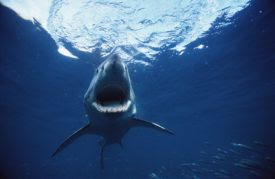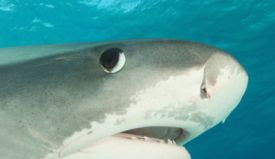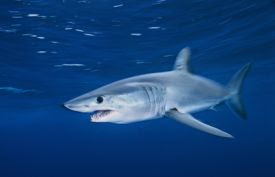5 Most Dangerous Sharks
Saturday, November 8, 2008




 Click here to read more...
Click here to read more...
Posted byParvez Ahmed at 11:08 PM 1 comments
Brain Foods That Make You Super Smart
 Everything that you consume influences your brain's performance. When you consume food, it's broken down into energy that's circulated throughout the body, and the brain picks up a large portion of it. Despite just weighing only 2 percent of a human's body weight, the brain calls for about 20 percent of energy taken in to keep running.
Everything that you consume influences your brain's performance. When you consume food, it's broken down into energy that's circulated throughout the body, and the brain picks up a large portion of it. Despite just weighing only 2 percent of a human's body weight, the brain calls for about 20 percent of energy taken in to keep running.That energy arrives to the brain via blood vessel transport, which means that diets that are fine for the heart are also fine for the brain. A diet that keeps the heart pumping and the arteries clear, blended with exercise, will enable that vital life force to arrive at the brain. Keeping up a flow of nutrients to the brain will also avoid brain disorders such as depression and dementia. That means you can multitask when it come to mealtimes; diets low in cholesterin and high in fiber profit many parts of the body.
What kinds of brain foods are really a kick-starter for our smarts and improve our intelligence?
To operate at its very best, the brain calls for fat and sugar. That may sound surprising, given how often we're discouraged away from those two substances. However, the brain is the lone organ that draws nearly all its energy from glucose. It's also the body's second-highest bank of fat, after fatty tissue itself (such as the butt and the gut)
Your brain cells thirst for polyunsaturated fatty acids, which you may know by the names omega-6 and omega-3. We typically get enough omega-6 acids throughout the day thanks to their presence in soy and corn oils, but most people need to eat more omega-3 fatty acids.
In an Australian study, children who drank in a drink with omega-3 fatty acids received higher scores on tests of intelligence and retention compared to children who didn't have the drink; results were apparent after just six months.
Omega-3 fatty acids are found in some nuts, such as walnuts and hazelnuts, flaxseed, kiwi and most importantly, fish.
Your brain also demands glucose to function properly. The glucose supply should be regular, so that means no skipping meals. It also means you should avoid a cheesy source of glucose, like a candy bar. Candy will give you a quick high and a plumping low in terms of glucose levels, and if you've ever felt a sugar crash, you know what that can do to your body. To furnish a steady stream of glucose, you should look for food that slowly discharges carbohydrates into the bloodstream, which include most fruits and vegetables, milk and breads with lots of grains. Foods such as candy and white bread just give you the sugar surge.
Glucose is crucial for keeping the neurotransmitters in the brain at peak levels. Yogurt also aids the yield of neurotransmitters thanks to its amino acids. Choline, a nutrient found in eggs and soybeans, creates a neurotransmitter called acetylcholine; abnormally low levels of acetylcholine have been detected in people with Alzheimer's disease, so you know you want to keep yours up. Folic acid, necessary for brain function, can be found in spinach and orange juice. And don't be afraid of zesting it up a bit; curcumin, a spice used in curries, may be one cause why India has such a low incidence of Alzheimer's.
But don't go too crazy with all these brain foods. When you devour too many calories, you can undo the positive brain effects. In the process of changing glucose to energy, extra oxygen is produced as unstable molecules called free radicals. Free radicals in turn cause oxidative stress by destructing brain cells they come in contact with. Not only does this oxidative stress force the brain's synapses to work heavier, it's also a major factor in many diseases, which is why you so often hear about the gains of antioxidants.
Fruits and vegetables are full of the antioxidants that can combat those free radicals. Load up on a salad of spinach, broccoli, carrots and onions, and don't forget to throw some berries on top.
Keeping your brain campaigning smoothly by means of refueling it with the right brain food is just one step to increasing your intelligence, though. Eating the right brain food will clear the footpaths for knowledge to zoom around the brain, but you'll have to put it there. Click here to read more...
Posted byParvez Ahmed at 10:03 PM 5 comments
Battle of the Bulge - Photos
Friday, November 7, 2008








Posted byParvez Ahmed at 9:06 PM 0 comments
Labels: History, War History
World's Most Prolific Serial Killer
 Believe it or not, a woman is the most prolific serial killer of all time. Erzsébet (Elizabeth) Bathory, a Hungarian countess, is considered to have murdered as many as 650 people during the 54 years she lived. Moreover, precisely how the world's most prolific serial killer took the lives of her victims has proven grisly fodder for storytellers. Bram Stoker is thought to have been inspired by the countess: His Count Dracula is purportedly a hybrid of Wallachian prince Vlad Tepes and Bathory.
Believe it or not, a woman is the most prolific serial killer of all time. Erzsébet (Elizabeth) Bathory, a Hungarian countess, is considered to have murdered as many as 650 people during the 54 years she lived. Moreover, precisely how the world's most prolific serial killer took the lives of her victims has proven grisly fodder for storytellers. Bram Stoker is thought to have been inspired by the countess: His Count Dracula is purportedly a hybrid of Wallachian prince Vlad Tepes and Bathory.Elizabeth Bathory, the woman who came to be acknowledged as the "Blood Countess," was born into Hungarian aristocracy in 1560. She is said to have sustained from fits and outbursts of madness -- possibly even epilepsy. From an early age, she found her father's officers torturing the peasantry that lived near her family's estate. Most historical analysis of the countess includes young Elizabeth as witness to a captured thief being sewed into the stomach of a dying horse and left to perish.
Bathory had a penchant for torturing immature girls in particular -- historians posit that she was bisexual person. The acts she perpetrated ranged from driving needles through her servants' lips and fingernails, to leaving her victims naked in the snow, submersing them with water and letting them freeze to death. One servant girl was battered by Bathory and an accomplice for stealing a pear. The clubbing was so bloody that Bathory had to switch her shirt. The girl was beaten for hours and at last stabbed to death with a pair of scissors.
Late in 1610, Elizabeth's cousin carried on a raid on Bathory's castle. Inside, there were already dead victims and some captives, supposedly awaiting death. Bathory's confederates were arrested and put on trial -- she never was. Instead, she was walled into her room, with just adequate space for air and food to pass through. She spent the remaining four years of her life there, until she was found dead on the floor in 1614. Her bloody life, whether amplified or factual, had come to an end -- and Bathory entered the realm of legend. Click here to read more...
Posted byParvez Ahmed at 3:17 AM 0 comments
Labels: crime and criminals, People
Judas Goat
 A Judas goat is a skilled goat employed at a slaughterhouse and in general animal herding. The Judas goat is conditioned to associate with sheep or cattle, conducting them to a particular destination. In yards, a Judas goat will conduct sheep to slaughter, while its own life is saved. Judas goats are also employed to lead other animals to specific pens and on to lorries.
A Judas goat is a skilled goat employed at a slaughterhouse and in general animal herding. The Judas goat is conditioned to associate with sheep or cattle, conducting them to a particular destination. In yards, a Judas goat will conduct sheep to slaughter, while its own life is saved. Judas goats are also employed to lead other animals to specific pens and on to lorries.The term is a mention to the biblical betrayer Judas Iscariot.
The phrase has also been used to depict a goat that is used to find ferine goats that are targeted for obliteration. The Judas goat is equipped with a transmitter, painted in red and then loosed. The goat then finds out the remaining herds of ferine goats, providing hunters to eliminate them.
The phrase was also used in WWII to denote bright colored airplanes used to marshall fleet of bombers before venturing on a mission.
In the Star Trek episode "Metamorphosis", Kirk asks Cochrane to entice in an alien in order to attack it, to which Cochrane replies, "What was it they used to call it ... the Judas goat?"
Also in the movie The Wild Bunch by Sam Peckinpah the railroad man Harrigan tells to the character played by Robert Ryan, "You are my Judas goat Mr.Thornton" pointing that as a erstwhile member of the Bunch, he is being used to fetch the remaining members of the mob. Click here to read more...
Posted byParvez Ahmed at 1:43 AM 0 comments
The Gremlins of Sulawesi
Thursday, November 6, 2008
 It is hushed along the black sand beach of Tangkoko forest. The light from the quartern moon oozes through the thick rainforest canopy throwing moonbeams across the forest floor. Two high-pitched squeaks emanate somewhere within a fig tree, and a tiny tennis-ball sized tarsier comes out from the tree hole. All of a sudden, he flies through the air with its long tail trailing behind, cuts across moon rays and lands on a gecko. It stumps on the gecko's tail and while seizing its neck with its right hand, with a quick jerk of the hand, the gecko's neck is cracked, and dinner is served.
It is hushed along the black sand beach of Tangkoko forest. The light from the quartern moon oozes through the thick rainforest canopy throwing moonbeams across the forest floor. Two high-pitched squeaks emanate somewhere within a fig tree, and a tiny tennis-ball sized tarsier comes out from the tree hole. All of a sudden, he flies through the air with its long tail trailing behind, cuts across moon rays and lands on a gecko. It stumps on the gecko's tail and while seizing its neck with its right hand, with a quick jerk of the hand, the gecko's neck is cracked, and dinner is served.Their owl-like eyes, mobile ears, haunting songs, and nighttime habits reenforce the tarsier's image as gremlins. These gremlins of the forest are found throughout Asia. But the species found in Sulawesi, T. dianae, T. spectrum, T. pelengensis, T. pumilus, and T. sangirensis are witnessed only in Sulawesi. Sulawesi is a paradise for evolutionary scientists and wildlife enthusiasts. Sulawesi is an evolutionary mongrel bringing together plants and animals from adjacent biological regions, Asia which includes Borneo and Australasia which includes Irian Jaya. As a result of this mix and a long period of reclusiveness, Sulawesi has created an enormous amount of evolutionary originals.
Tarsiers are often found in forest understorey where they hunt for insects and small reptiles. They perch about a meter off the forest floor and scan the ground for prey, and jump incredible lengths. This jumping ability comes from the extension of their tarsal (ankle) region and fusion of the two lower leg bones, hence the name tarsius. They can turn their head a full 180 degrees; so that they can leap rearwards without running flat into a tree trunk. Often found in a family unit, a mother, father, and infant, the mother and father hunt for food while leaving the infant in the tree nest. Once hunting jobs are finished and the day breaks, the family reunite for daytime slumber. Although they do not need large forest areas, they face threats common to all tropical rainforest animals. Their populations are negatively affected by habitat loss and disturbance, and capture for merchandise. Click here to read more...
Posted byParvez Ahmed at 7:30 PM 0 comments
Pain Index - Insect Bites
 The Schmidt Sting Pain Index or the Justin O. Schmidt Pain Index is a pain scale grading the relative pain made by different insect stings. It is chiefly the work of Justin O. Schmidt, a bugologist at the Carl Hayden Bee Research Center. Schmidt has brought out a number of papers on the subject and lays claim to have been stung by the bulk of stinging wasps, ants, ichneumons, sawflies, gall wasps, etc.
The Schmidt Sting Pain Index or the Justin O. Schmidt Pain Index is a pain scale grading the relative pain made by different insect stings. It is chiefly the work of Justin O. Schmidt, a bugologist at the Carl Hayden Bee Research Center. Schmidt has brought out a number of papers on the subject and lays claim to have been stung by the bulk of stinging wasps, ants, ichneumons, sawflies, gall wasps, etc.- Pain Index 1.0 - Sweat bee: Light, short-lived, almost fruity. A tiny spark has seared a single hair on your arm.
- Pain Index 1.2 - Fire ant: Sharp, abrupt, mildly alarming. As if walking across a shag carpet & reaching for the light switch.
- Pain Index 1.8 - Bullhorn acacia ant: A rare, piercing, advanced sort of pain. Someone has fired a staple into your face.
- Pain Index 2.0 - Bald-faced hornet: Rich, hearty, slightly crisp. Similar to getting your hand squeezed in a revolving door.
- Pain Index 2.0 - Yellowjacket: Hot and smoking, almost irreverent. Imagine W. C. Fields blowing out a cigar on your tongue.
- Pain Index 2.x - Honey bee and European hornet: Like a matchhead that flips off and burns up on your skin.
- Pain Index 3.0 - Red harvester ant: Bold and unforgiving. Somebody is using a drill to excavate your ingrowing toenail.
- Pain Index 3.0 - Paper wasp: Caustic & burning. Distinctly bitter afterimage. Like running out a beaker of hydrochloric acid on a paper cut.
- Pain Index 4.0 - Tarantula hawk: Blinding, ferocious, shockingly electric. A running hair drier has been dropped down into your bubble bath.
- Pain Index 4.0+ - Bullet ant: Pure, acute, bright pain. Like fire-walking over flaming charcoal with a 3-inch rusty nail in your heel.
Posted byParvez Ahmed at 4:05 AM 2 comments
Labels: animals, offbeat, others, science
Neurosyphilis
Definition of Neurosyphilis
Neurosyphilis refers to a site of infection involving the central nervous system (CNS). Neurosyphilis may occur at any stage of syphilis. Before the advent of antibiotics, it was typically seen in 25-35% of patients with syphilis.
Causes of Neurosyphilis
Neurosyphilis occurs about 10 to 20 years after first being infected with syphilis. It is considered a life-threatening complication of syphilis. Not everyone who has syphilis will develop this complication.
There are four different forms of neurosyphilis:
* Asymptomatic
* Meningovascular
* Tabes dorsalis
* General paresis
Asymptomatic neurosyphilis occurs before symptomatic syphilis. Signs of the disease may be seen in the spinal fluid, but the person has no symptoms.
Meningovascular neurosyphilis causes nerve and eye problems, among other symptoms. There may be damage to the blood vessels, which can lead to a stroke.
Persons with tabes dorsalis have damage to the spinal cord that slowly gets worse, making them unable to walk.
In general paresis, brain cell damage causes paralysis, tremors, seizures, and mental decline. Inflammation may occur anywhere in the brain or spinal cord and can lead to a number of neurological problems.
Symptoms of Neurosyphilis
* Headache
* Stiff neck
* Irritability
* Poor concentration
* Mental confusion
* Depression
* Visual disturbances
* Abnormal reflexes
* Abnormal gait (walk)
* Incontinence
* Dementia
* Weakness, numbness of lower extremities
* Loss of muscle function
* Muscle contractions
* Muscle atrophy
Note: There may be no symptoms
Neurosyphilis in Literature
First, William Shakespeare wrote, in The Life of Timon of Athens, referencing the venereal nature of syphilis:Click here to read more...
This fell whore of thine
Hath in her more destruction than thy sword,
For all her cherubim look."
Second, Isaac Asimov wrote in Limericks, under "Luetic Lament,":
There was a young man of Back Bay
Who thought syphilis just went away.
And thought that a chancre
Was merely a canker
Acquired in lascivious play.
Now first he got acne vulgaris,
The kind that is rampant in Paris
It covered his skin
From forehead to shin
And now people ask where his hair is.
With symptoms increasing in number,
His aorta's in need of a plumber
His hear is cavorting
His wife is aborting
And now he's acquired a gumma.
Consider his terrible plight -
His eyes won't react to the light
His hands are apraxic.His gait is ataxic.
He's developing gun-barrel sight.
His passions are strong as before
But his penis is flaccid, and sore.
His wife now has tabes
And sabre-shinned babies
She's really worse off than a whore.
There are pains in his belly and knees.
His sphincters have gone by degrees.
Paroxysmal incontinence,
With all its concomitants,
Brings on quite unpredictable pees.
Though treated in every known way,
His spirochetes grow day by day.
He's developed paresis,
Converses with Jesus,
And thinks he's the Queen of the May."
This poetic manifest reveals the myriad of sickening phenomenon arising from this chronic, indolent infection.
Posted byParvez Ahmed at 2:20 AM 1 comments
How Did Houdini Die
Wednesday, November 5, 2008
 Harry Houdini was a great magician who was best known for his superb stunts and feats of escapology. Harry Houdini died in 1926 due to peritonitis secondary to a busted appendix. It has been speculated that Houdini was murdered by a McGill University student, J. Gordon Whitehead, in Montreal. Houdini expired of a ruptured appendix, caused by Whitehead delivering numerous blows to Houdini's stomach.
Harry Houdini was a great magician who was best known for his superb stunts and feats of escapology. Harry Houdini died in 1926 due to peritonitis secondary to a busted appendix. It has been speculated that Houdini was murdered by a McGill University student, J. Gordon Whitehead, in Montreal. Houdini expired of a ruptured appendix, caused by Whitehead delivering numerous blows to Houdini's stomach.The witnesses were pupils named Jacques Price and Sam Smilovitz. Their accounts mostly agreed.
The following is according to Price's description of events -
Houdini was leaning back on his couch after his public presentation, having an art student sketch him. When Whitehead came in and asked if it was genuine that Houdini could take any blow to the abdomen. Houdini responded in the affirmative. In this instance, he was hit three times, before Houdini dissented. Whitehead reportedly kept on hitting Houdini several times afterwards, and Houdini behaved as though he were in some pain. Price recited that Houdini stated that if he had had time to ready himself the right way, he would have been in a better position to take the blows. Although in grievous pain, Houdini nonetheless remained to travel without looking for medical attention.
Harry had apparently been suffering from appendicitis for several days and declining medical treatment. His appendix would likely have ruptured on its own without the trauma. Click here to read more...
Posted byParvez Ahmed at 9:14 PM 5 comments
Labels: People
10 Wild Cat Species
Sunday, November 2, 2008

Click here to read more...
Posted byParvez Ahmed at 8:24 AM 7 comments
Naked Pumpkin Run

Boulder police have fined about a dozen people running nude on the street while sporting fresh emptied pumpkins on their heads as part of an annual Halloween event called the Naked Pumpkin Run.
The citations for indecorous exposure Friday night came in as dozens of other dressed up merrymakers, including a man with a red cape and a sword, chanted to police officers to let go of the flashers and to find actual outlaws.
The event known in Boulder as the Naked Pumpkin Run has been held for 10 years. This year it attracted a huge crowd, prompting concern from police.
Boulder police Chief Mark Beckner says officers "wanted to do something before (the event) got out of hand." Click here to read more...
Posted byParvez Ahmed at 6:53 AM 0 comments











